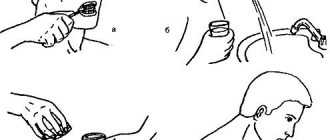- Why does snot run down the back of the throat?
- Symptoms of postnasal drip
- Complications of the syndrome
- How to remove nighttime mucus drainage
- Treatment of snot in the throat of a child
- Treatment of snot in the throat in an adult
When snot runs down the back of your throat, the condition is called postnasal drip or postnasal drip syndrome. Why does this condition occur and what are the complications?
Normally, a small amount of mucus is constantly present in the nasopharynx, which is produced by the exocrine glands. The mucus mixes with saliva and moves further into the digestive tract. Mucus is necessary to moisturize and cleanse the nasal cavity and nasopharynx from foreign substances that enter the respiratory tract with air. This process is absolutely physiological and does not cause any inconvenience. Discomfort occurs when the amount of mucus increases and its viscosity changes. Postnasal drip syndrome is a pathological condition and requires attention from a specialist.
Why does snot run down the back of the throat?
The pathology accompanies a number of ENT diseases. Possible reasons why snot runs down the back of the throat are:
- proliferation of adenoids;
- congenital anomalies of the structure of the mucous membrane of the posterior wall of the nasopharynx;
- deviated nasal septum;
- rhinosinusitis of various etiologies accounts for more than 50% of identified clinical cases;
- entry of a foreign body into the nasal cavity.
Women may experience the appearance of snot in the throat during pregnancy. A similar situation arises for people who work in hazardous industries or live in regions with poor ecology, or smokers. Chemical fumes, tobacco smoke, and particles of household chemicals entering the respiratory tract lead to irritation of the mucous membrane, so mucus production increases and snot flows into the throat.
The problem of leakage appears when taking certain medications. In particular, such a situation may be associated with the uncontrolled use of vasoconstrictor nasal drops. While the patient is using these medications, postnasal drip of mucus is observed. After discontinuation of the drug, mucus production normalizes and unpleasant symptoms disappear.
Some people experience snot running down their throats when the temperature and humidity change. When the microclimate is normalized, the human condition improves.
In some cases, the appearance of postnasal drip in adults and children is in no way associated with ENT diseases. The cause is pathology of the digestive organs, which is accompanied by gastroesophageal reflux. The contents of the stomach are regularly thrown into the esophagus, which causes belching, sore throat, and irritation of the mucous membrane. For this reason, mucus production increases and postnasal drip appears.
In some patients, this symptom is accompanied by endocrine pathologies leading to hormonal imbalance.
Causes of mucous sputum
Chronic rhinitis
Cough with mucous sputum during rhinitis is caused by irritation of the back wall of the pharynx by flowing mucus. The patient experiences soreness and a sensation of a foreign body in the throat, to eliminate which a cough reflex occurs. Expectoration of a small amount of clear discharge occurs in the morning after sleep, as well as during prolonged periods of lying down. After coughing up mucous sputum, the discomfort disappears.
Pharyngitis
For inflammation of the pharynx, a dry cough is typical, but sometimes it turns into a wet cough with the release of mucous sputum. Pharyngitis is manifested by expectoration of a small amount of clear mucus that does not have an unpleasant odor. The symptom persists for 3-5 days, combined with a constant sore throat. An attack of coughing with expectoration of sputum begins without visible provoking factors, but can intensify with loud speech or inhalation of cold air.
Chronic hyperplastic laryngitis
This pathology is characterized by the release of a scant amount of mucous sputum in the morning, accompanied by a sore throat and coughing. The symptom bothers a person for 3 weeks or more. For laryngitis, a constant sensation of a foreign body and discomfort in the throat is pathognomonic. An attempt to cough results in the appearance of a small amount of mucus, usually without bringing relief.
Tracheitis
The disease manifests itself with the release of clear mucus after a paroxysmal painful cough. Gradually, the volume of mucous sputum increases and it becomes cloudy. If tracheitis develops against the background of a bacterial infection, purulent streaks appear in the mucous secretion. Patients complain of frequent cough paroxysms that occur when laughing, talking loudly, or taking deep breaths.
Bronchitis
Coughing up medium or large amounts of mucous sputum is a typical sign of bronchial catarrh. In an acute process, a constant cough and the discharge of clear or cloudy mucus without an odor are disturbing. Symptoms last 1-3 weeks. In chronic bronchitis, expectoration of mucous discharge lasts several weeks or even months. Coughing up mucous sputum in the morning is typical of smoker's bronchitis.
Mucous sputum
Atypical pneumonia
Expectoration of large amounts of mucus occurs with pneumonia of viral or mycoplasmal etiology. Sputum production begins 2-4 days after the onset of the disease. The mucus is clear, without pathological inclusions, sometimes it is viscous and difficult to cough up. The symptom is supplemented by febrile fever and chest pain. If coughing and expectoration of mucous sputum lasts more than 3 months, prolonged pneumonia is diagnosed.
Whooping cough
A cough with expectoration of mucous sputum is characteristic of the period of resolution of the infectious process. At this time, cough paroxysms become rare and less durable; after an attack, the child spits out clear mucus in small quantities. Given the severity of whooping cough, symptoms last from several days to several months. Gradually, the amount of secreted mucous sputum decreases.
Pulmonary edema
The release of clear sputum when coughing is observed at the stage of alveolar edema, when fluid enters the lungs from the blood vessels. The condition develops suddenly, the patient experiences difficulty breathing and tries unsuccessfully to clear his throat. The amount of mucus secreted increases. In severe cases, instead of mucous sputum, pink foam appears when breathing and coughing, indicating the entry of red blood cells from the blood into the alveoli.
Lung adenocarcinoma
In the initial stages of the disease, a person is bothered by periodic coughing, accompanied by the release of liquid transparent mucus. As a malignant tumor progresses, a large amount (up to 1-2 liters per day) of watery sputum is formed in the lungs and bronchi, which the patient is forced to constantly cough up to make breathing easier. If adenocarcinoma grows into surrounding tissue, the mucus is replaced by bloody sputum.
Foreign body of the bronchus
If the foreign object is small, breathing is preserved. The patient is bothered by a periodic cough, during which clear liquid mucus is coughed up. Symptoms are observed until the foreign body is removed. If this does not happen, inflammation develops in the bronchus with an increase in the amount of mucous sputum secreted, which over time becomes more cloudy and viscous.
How to remove nighttime mucus drainage
During the daytime, the clinical manifestations of the disease are less pronounced, since the body is in an upright position. The person simply swallows the bulk of the discharge. At night, when the body is in the “lying” position, mucus flows to the reflexogenic areas of the laryngopharynx. This irritates them and leads to severe coughing. For this reason, nighttime mucus discharge causes serious discomfort and interferes with normal rest.
To get rid of the problem, you need to identify its cause by contacting a specialist. The doctor may prescribe rinsing the nasal cavity, irrigating the nose with a spray with silver ions, or steam inhalation. You should also keep your sleeping area humid and drink plenty of fluids to help relieve postnasal drip at night.
Coughing up white mucus without coughing
Enveloping the larynx with white mucus without a reflexive attempt to remove it is a common reason for patients to see a doctor. Most often, this is pure physiology, not dangerous to health: unfavorable ecology, food irritating the mucous membranes, alcoholic drinks.
If, in addition to sputum, cold symptoms appear: runny nose, headache and fever, this is a reason to consult a doctor.
Most likely, acute respiratory infections provoked an exacerbation of a latent process, which is localized in the upper respiratory tract and does not manifest itself in anything other than hypersecretion of mucus. The pathology does not descend into the bronchi, so there is no cough. But such “innocence” may hide tumors of the nasopharynx, so consultation with a specialist is necessary.
For prevention purposes, any expectoration of white mucus without coughing for a couple of days is a reason to visit a therapist.
An examination with special equipment and a series of tests will allow you to determine the true cause of hypersecretion and prescribe therapy or send you to a specialized specialist.
Treatment of snot in the throat of a child
If postnasal drip occurs in a child, a consultation with an ENT doctor is required. The specialist assesses the condition of the upper respiratory tract, collects information about recent diseases, congenital or acquired anomalies of the upper respiratory system. Hardware diagnostic procedures include: rhinoscopy, mesopharyngoscopy, radiography or CT. This allows you to identify the cause that triggered the flow of mucus into the throat and determine how to treat postnasal drip. When identifying an inflammatory process, it is important to determine its cause. A general blood test helps with this. In bacterial infections, leukocytosis with increased ESR is observed. Viral infections lead to neutropenia and lymphocytosis. Allergic reactions are promoted by eosinophilia.
In most cases, the pathology can be eliminated with conservative therapy. If the cause is rhinitis or sinusitis, it is important to determine the nature of the rhinitis. For bacterial infections, antibiotics are indicated. If the inflammatory process is caused by a virus or allergen, symptomatic treatment is used. If snot runs down the back of the throat, antihistamines and corticosteroids may also be used for treatment. They help relieve swelling of the mucous membrane and thereby relieve symptoms.
For severe coughs, antitussive drugs are prescribed: expectorants and other drugs.
Treatment
Help before diagnosis
In case of acute inflammatory damage to the respiratory system, unimpeded discharge of mucous sputum should be ensured. To improve the drainage function of the bronchial tree, it is recommended to drink plenty of warm drinks and maintain optimal air humidity in the room. All drug treatments can only be used after a visit to a doctor.
Conservative therapy
Mucous sputum as a symptom does not require special treatment, since it disappears after affecting the underlying disease. In cases where there is too much mucus and its expectoration is difficult, postural drainage techniques are recommended, and medications with mucolytic and secretomotor effects are prescribed. Physiotherapy methods are effective - alkaline and oil inhalations, UHF and electrophoresis on the anterior surface of the chest.
To influence the root causes of the discharge of mucous sputum, antiviral and antiallergic drugs are used. Antibiotics are not indicated; they are used only when the bronchial discharge is mucopurulent. Anti-inflammatory medications speed up recovery and relieve subjective symptoms. For chronic bronchitis, therapeutic bronchoscopy is performed for lavage and targeted administration of medications.
Treatment of snot in the throat in an adult
Postnasal drip syndrome affects people of all ages. To find out how to get rid of snot in the throat, an adult patient also needs to consult an ENT doctor. The specialist will prescribe a set of examinations to identify the cause of the pathology and appropriate treatment.
What to do if the snot in the throat does not go away after taking medications? This situation may be caused by incorrectly selected therapy or structural abnormalities of the intranasal structures and paranasal sinuses. In this case, the doctor may choose a different conservative therapy regimen or recommend surgical treatment.
Patients with a deviated nasal septum undergo septoplasty. This is an endoscopic operation that is aimed at eliminating deformation of the nasal septum without changing the shape of the external nose. Thanks to this procedure, nasal breathing is restored and one of the main causes of rhinitis and sinusitis, which provoke postnasal drip, is eliminated.
If there are indications, the patient may undergo surgery to resect concha bullosa or remove a Thornwaldt cyst, a cyst-like formation in the nasopharynx. It causes postnasal drip, which is difficult to respond to conservative therapy. After the operation, the patient's condition usually returns to normal.
Without an examination, it is impossible to say how to treat snot in the throat, so this situation requires mandatory attention from specialists.
1.General information
It would seem that any person who has had a runny nose at least once is familiar with this uncomfortable sensation: somewhere in the depths of the nasopharynx, something has accumulated and interferes with every swallow, and it is necessary to get rid of it urgently, by any means... Considering that a runny nose is the most common from painful human conditions, we can safely assume: this feeling of “internal runny nose” is known to everyone, and it is known so well that there seems to be nothing to talk about here. In the end, the mucous membranes of the nasopharynx normally produce large volumes of secretion, some of which flows down the back wall, is swallowed with saliva and food, sometimes accumulates - for example, after a night's sleep - but, in general, does not create any special problems.
However, the flow of moisturizing and bactericidal mucus along the posterior nasopharyngeal wall into the laryngopharynx is not always “normal” and problem-free. It's all about the causes of hypersecretion, the composition and properties of mucus, and its quantity.
Rhinitis (runny nose) and accompanying rhinorrhea (profuse discharge of mucous discharge from the nasal passages) is, by and large, not a disease. This is a symptom, a sign of a particular pathology. Sometimes this symptom is quite expected and really does not have any particular clinical significance, but in some cases it requires special attention and examination. For such cases, a special term has been introduced, which is found in the literature in several synonymous spellings: postnasal drip syndrome (English: “postnasal drip syndrom”), retronasal drip (sometimes written “drip”), retronasal discharge, internal runny nose, postnasal syndrome. It was first described at the end of the 18th century under the name “chronic pharyngeal catarrh.”
A must read! Help with treatment and hospitalization!
3. Symptoms and diagnosis
In addition to the interfering sensation described above, a feeling of congestion and an increased swallowing (and sometimes gag) reflex designed to “clear the throat,” retronasal drip is one of the causes of chronic cough, since excess amounts of mucus, flowing into the laryngopharynx, mechanically irritate the cough receptors. Often there is also pain in the tonsils and/or pharynx, a “lump in the throat” due to reflex swelling, and in more severe cases – dysphonia, hoarseness, and symptoms of salpingootitis.
As a rule, with an upright position of the body, the symptoms are significantly alleviated, and when lying down, especially for a long time, they worsen.
Diagnostics includes the study of complaints and medical history, a detailed examination of the ENT organs, as well as, as necessary, the use of additional research methods (endoscopic, tomographic, laboratory, etc.). In some cases, consultation with specialized specialists is necessary, for example, an allergist, an infectious disease specialist, etc.
Differential diagnosis is carried out with chronic bronchitis and other clinically similar conditions.
About our clinic Chistye Prudy metro station Medintercom page!








